Related Research Articles

The cryosphere is an umbrella term for those portions of Earth's surface where water is in solid form. This includes sea ice, ice on lakes or rivers, snow, glaciers, ice caps, ice sheets, and frozen ground. Thus, there is a overlap with the hydrosphere. The cryosphere is an integral part of the global climate system. It also has important feedbacks on the climate system. These feedbacks come from the cryosphere's influence on surface energy and moisture fluxes, clouds, the water cycle, atmospheric and oceanic circulation.

In glaciology, an ice sheet, also known as a continental glacier, is a mass of glacial ice that covers surrounding terrain and is greater than 50,000 km2 (19,000 sq mi). The only current ice sheets are the Antarctic ice sheet and the Greenland ice sheet. Ice sheets are bigger than ice shelves or alpine glaciers. Masses of ice covering less than 50,000 km2 are termed an ice cap. An ice cap will typically feed a series of glaciers around its periphery.

Post-glacial rebound is the rise of land masses after the removal of the huge weight of ice sheets during the last glacial period, which had caused isostatic depression. Post-glacial rebound and isostatic depression are phases of glacial isostasy, the deformation of the Earth's crust in response to changes in ice mass distribution. The direct raising effects of post-glacial rebound are readily apparent in parts of Northern Eurasia, Northern America, Patagonia, and Antarctica. However, through the processes of ocean siphoning and continental levering, the effects of post-glacial rebound on sea level are felt globally far from the locations of current and former ice sheets.
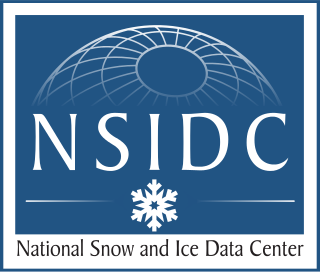
The National Snow and Ice Data Center (NSIDC) is a United States information and referral center in support of polar and cryospheric research. NSIDC archives and distributes digital and analog snow and ice data and also maintains information about snow cover, avalanches, glaciers, ice sheets, freshwater ice, sea ice, ground ice, permafrost, atmospheric ice, paleoglaciology, and ice cores.
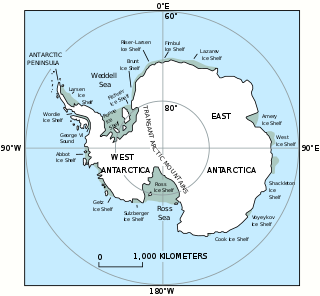
The West Antarctic Ice Sheet (WAIS) is the segment of the continental ice sheet that covers West Antarctica, the portion of Antarctica on the side of the Transantarctic Mountains that lies in the Western Hemisphere. It is classified as a marine-based ice sheet, meaning that its bed lies well below sea level and its edges flow into floating ice shelves. The WAIS is bounded by the Ross Ice Shelf, the Ronne Ice Shelf, and outlet glaciers that drain into the Amundsen Sea.

The Antarctic ice sheet is a continental glacier covering 98% of the Antarctic continent, with an area of 14 million square kilometres and an average thickness of over 2 kilometres (1.2 mi). It is the largest of Earth's two current ice sheets, containing 26.5 million cubic kilometres of ice, which is equivalent to 61% of all fresh water on Earth. Its surface is nearly continuous, and the only ice-free areas on the continent are the dry valleys, nunataks of the Antarctic mountain ranges, and sparse coastal bedrock. However, it is often subdivided into East Antarctic ice sheet (EAIS), West Antarctic ice sheet (WAIS), and Antarctic Peninsula (AP), due to the large differences in topography, ice flow, and glacier mass balance between the three regions.

Richard Blane Alley is an American geologist and Evan Pugh Professor of Geosciences at Pennsylvania State University. He has authored more than 240 refereed scientific publications about the relationships between Earth's cryosphere and global climate change, and is recognized by the Institute for Scientific Information as a "highly cited researcher."
William Richard Peltier, Ph.D., D.Sc. (hc), is university professor of physics at the University of Toronto. He is director of the Centre for Global Change Science, past principal investigator of the Polar Climate Stability Network, and the scientific director of Canada's largest supercomputer centre, SciNet. He is a fellow of the Royal Society of Canada, of the American Geophysical Union, of the American Meteorological Society, and of the Norwegian Academy of Science and Letters..
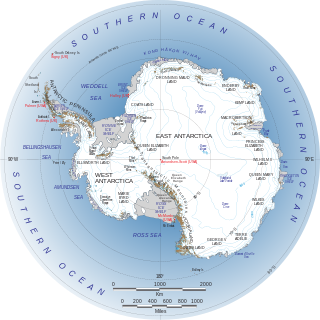
The East Antarctic Ice Sheet (EAIS) lies between 45° west and 168° east longitudinally. It was first formed around 34 million years ago, and it is the largest ice sheet on the entire planet, with far greater volume than the Greenland ice sheet or the West Antarctic Ice Sheet (WAIS), from which it is separated by the Transantarctic Mountains. The ice sheet is around 2.2 km (1.4 mi) thick on average and is 4,897 m (16,066 ft) at its thickest point. It is also home to the geographic South Pole, South Magnetic Pole and the Amundsen–Scott South Pole Station.
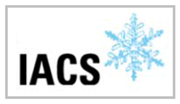
The International Association of Cryospheric Sciences (IACS) is the eighth association of the International Union of Geodesy and Geophysics (IUGG). It was launched by the IUGG Council on 4 July 2007, developing from the International Commission of Snow and Ice of the International Association of Hydrological Sciences (IAHS) via the transitional Union Commission for the Cryospheric Sciences (UCCS).
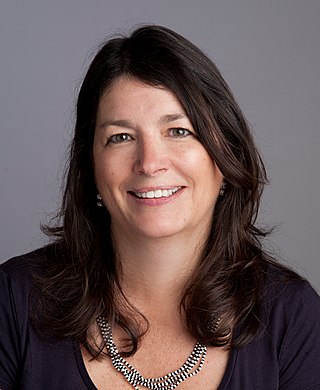
Maureen E. Raymo is an American paleoclimatologist and marine geologist. She is the Co-Founding Dean Emerita of the Columbia Climate School and the G. Unger Vetlesen Professor of Earth & Environmental Sciences at Columbia University. From 2011 to 2022 she was also Director of Lamont-Doherty Earth Observatory's (LDEO) Core Repository and, until 2024, was the Founding Director of the LDEO Hudson River Field Station. From 2020 to 2023 she was first Interim Director then Director of Lamont-Doherty Earth Observatory, the first climate scientist and first female scientist to head the institution.
Helen Amanda Fricker is a glaciologist and professor at Scripps Institution of Oceanography at the University of California, San Diego where she is a director of the Scripps Polar Center. She won the 2010 Martha T. Muse Prize for Science and Policy in Antarctica.

Terry Jean Wilson is an international leader in the study of present-day tectonics in Antarctica. She has led large, international efforts, such as Polar Earth Observing Network (POLENET), to investigate the interactions between the Earth's crust and the cryosphere in Antarctica.

Robin Elizabeth Bell is Palisades Geophysical Institute (PGI) Lamont Research Professor at Columbia University's Lamont–Doherty Earth Observatory and a past President of the American Geophysical Union (AGU), 2019–2021. Dr. Bell was influential in co-ordinating the 2007 International Polar Year and was the first woman to chair the National Academy of Sciences Polar Research Board. She has made numerous important discoveries with regard to subglacial lakes and ice sheet dynamics, and has a ridge, called Bell Buttress, in Antarctica named after her.

Frank Jean-Marie Léon Pattyn is a Belgian glaciologist and professor at the Université libre de Bruxelles. He is best known for developing ice-sheet models and leading model intercomparisons.
Sophie Marie Jeanne Nowicki, is Empire Innovation Professor in the Department of Geology of the University at Buffalo. She does research on the Greenland and Antarctic ice sheets, focusing on their connections to global climate and sea level. Before that, she was physical scientist at the Nasa Goddard Space Flight Centre, investigating ice sheet changes.

Amelia E. Shevenell is an American marine geologist who specializes in high-latitude paleoclimatology and paleoceanography. She is currently a Professor in the College of Marine Science at the University of South Florida. She has made notable contributions to understanding the history of the Antarctic ice sheets and published in high-impact journals and, as a result, was awarded full membership of Sigma Xi. She has a long record of participation in international ocean drilling programs and has served in leadership positions of these organizations. Shevenell served as the elected Geological Oceanography Council Member for The Oceanography Society (2019-2021).

Jonathan Louis Bamber is a British physicist known for his work on satellite remote sensing of the polar regions and especially the Antarctic and Greenland ice sheets. He has authored more than 200 refereed scientific publications about the cryosphere and its interaction with the rest of the Earth System, and is recognised by the Institute for Scientific Information as a "highly cited researcher". In 2019 he was elected a fellow of the American Geophysical Union "For pioneering satellite remote sensing in glaciology and building bridges to other disciplines of the geoscience community." He is the first non-US scientist in the Cryosphere division to receive this honour.
Isabella Velicogna is a geoscientist known for her work using gravity measurements from space to study changes in the polar ice sheets and water storage on Earth.
John Matthew Wahr was an American geophysicist and geodesist, known for his research on Earth's rotation, Earth tides, ocean tides, post-glacial rebound, and other topics in the geosciences.
References
- ↑ "Natalya Gomez". Department of Earth and Planetary Sciences. Archived from the original on 2020-09-28. Retrieved 2019-09-10.
- ↑ "2019 AGU Section Awardees and Named Lecturers". Eos. Archived from the original on 2020-09-28. Retrieved 2019-09-10.
- ↑ "Natalya Gomez". eps.harvard.edu. Archived from the original on 2020-09-28. Retrieved 2019-09-10.
- ↑ Government of Canada, Industry Canada (2012-11-29). "Canada Research Chairs". www.chairs-chaires.gc.ca. Archived from the original on 2018-04-08. Retrieved 2019-09-10.
- ↑ "Natalya Gomez - Google Scholar Citations". scholar.google.com. Archived from the original on 2024-05-03. Retrieved 2019-10-05.
- ↑ Gomez, Natalya; Mitrovica, Jerry X.; Tamisiea, Mark E.; Clark, Peter U. (2010). "A new projection of sea level change in response to collapse of marine sectors of the Antarctic Ice Sheet". Geophysical Journal International. 180 (2): 623–634. Bibcode:2010GeoJI.180..623G. doi: 10.1111/j.1365-246X.2009.04419.x .
- ↑ Gomez, Natalya; Mitrovica, Jerry X.; Huybers, Peter; Clark, Peter U. (2010). "Sea level as a stabilizing factor for marine-ice-sheet grounding lines". Nature Geoscience. 3 (12): 850–853. Bibcode:2010NatGe...3..850G. doi:10.1038/ngeo1012. ISSN 1752-0894.
- ↑ Gomez, Natalya; Pollard, David; Mitrovica, Jerry X. (2013). "A 3-D coupled ice sheet – sea level model applied to Antarctica through the last 40 ky". Earth and Planetary Science Letters. 384: 88–99. Bibcode:2013E&PSL.384...88G. doi:10.1016/j.epsl.2013.09.042.
- ↑ Gomez, Natalya; Pollard, David; Holland, David (2015). "Sea-level feedback lowers projections of future Antarctic Ice-Sheet mass loss". Nature Communications. 6 (1): 8798. Bibcode:2015NatCo...6.8798G. doi:10.1038/ncomms9798. ISSN 2041-1723. PMC 5426515 . PMID 26554381.
- ↑ Gomez, Natalya; Latychev, Konstantin; Pollard, David (2018). "A Coupled Ice Sheet–Sea Level Model Incorporating 3D Earth Structure: Variations in Antarctica during the Last Deglacial Retreat". Journal of Climate. 31 (10): 4041–4054. Bibcode:2018JCli...31.4041G. doi: 10.1175/JCLI-D-17-0352.1 . ISSN 0894-8755.
- ↑ "Leadership". www.wcrp-climate.org. Archived from the original on 2020-09-28. Retrieved 2019-11-28.
- ↑ "2019 AGU Section Awardees and Named Lecturers". Eos. Archived from the original on 2020-09-28. Retrieved 2019-09-10.
- ↑ "International Association of Geodesy". www.iag-aig.org. Archived from the original on 2020-09-28. Retrieved 2019-09-10.
- ↑ "Natalya A Gomez". American Geophysical Union. Archived from the original on 2023-09-26. Retrieved 2023-10-23.